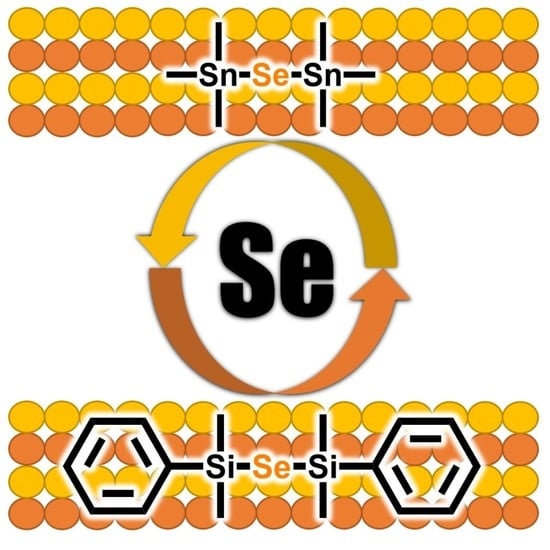Towards Volatile Organoselenium Compounds with Cost-Effective Synthesis
Abstract
:1. Introduction
2. Materials and Methods
2.1. Synthesis of Selenium Precursors
2.1.1. Bis(Trimethylstannyl)Selenide—(Me3Sn)2Se
2.1.2. Bis(Tributylstannyl)Selenide—(Bu3Sn)2Se
2.1.3. Triisopropylsilylselenole—iPr3Si–SeH
2.1.4. Bis(Dimethylphenylsilyl)Selenide—PhMe2Si–Se–SiMe2Ph
2.1.5. Bis(Triethylsilyl)Selenide—Et3Si–Se–SiEt3
2.1.6. Triisopropylsilyl–Trimethylsilylselenide—iPr3Si–Se–SiMe3
2.2. DSC and TGA Measurements
3. Results and Discussion
3.1. Straightforwad Reaction Pathway to Bis(Trialkylstannyl)Selenides
3.2. Elaboration with Silylselenides
3.3. Thermal Properties
4. Conclusions
Supplementary Materials
Author Contributions
Funding
Acknowledgments
Conflicts of Interest
References
- Wang, Q.; Lei, Y.; Wang, Y.; Liu, Y.; Song, C.; Zeng, J.; Song, Y.; Duan, X.; Wang, D.; Li, Y. Atomic-scale engineering of chemical vapor deposition-grown 2D transition metal dichalcogenides for electrocatalysis. Energy Environ. Sci. 2020. [Google Scholar] [CrossRef]
- Zhao, M.; Su, J.; Zhao, Y.; Luo, P.; Wang, F.; Han, W.; Li, Y.; Zu, X.; Qiao, L.; Zhai, T. Sodium-Mediated Epitaxial Growth of 2D Ultrathin Sb2Se3 Flakes for Broadband Photodetection. Adv. Funct. Mater. 2020, 30, 1909849. [Google Scholar] [CrossRef]
- Sun, Y.; Dai, T.; He, Z.; Zhou, W.; Hu, P.; Li, S.; Wu, S. Memristive phase switching in two-dimensional 1T’-VSe2 crystals. Appl. Phys. Lett. 2020, 116, 033101. [Google Scholar] [CrossRef]
- Yun, S.J.; Duong, D.L.; Ha, D.M.; Singh, K.; Phan, T.L.; Choi, W.; Kim, Y.M.; Lee, Y.H. Ferromagnetic Order at Room Temperature in Monolayer WSe2 Semiconductor via Vanadium Dopant. Adv. Sci. 2020, 7, 1903076. [Google Scholar] [CrossRef] [PubMed] [Green Version]
- George, S.M.; Yoon, B.; Hall, R.A.; Abdulagatov, A.I.; Hibbs, Z.M.; Lee, Y.; Seghete, D.; Lee, B.H. Atomic Layer Deposition of Nanostructured Materials; Pinna, N., Knez, M., Eds.; Wiley-VCH Verlag GmbH & Co. KGaA: Weinheim, Germany, 2012; ISBN 9780470109526. [Google Scholar]
- Ng, S.; Krbal, M.; Zazpe, R.; Přikryl, J.; Charvot, J.; Dvořák, F.; Strizik, L.; Slang, S.; Sopha, H.; Kosto, Y.; et al. MoSexOy-Nanotube Layers: Efficient Interface for Light-Driven Applications. Adv. Mater. Interfaces 2017, 5, 1701146. [Google Scholar] [CrossRef] [Green Version]
- Balasubramanyam, S.; Merkx, M.J.M.; Verheijen, M.A.; Kessels, W.M.M.; Mackus, A.J.M.; Bol, A.A. Area-selective atomic layer deposition of 2D WS nanolayers Area-selective atomic layer deposition of 2D WS 2 nanolayers Abstract With downscaling of device dimensions, two dimensional (2D) semiconducting transition metal. ACS Mater. Lett. 2020, 2, 511–518. [Google Scholar] [CrossRef] [PubMed] [Green Version]
- Pore, V.; Hatanpää, T.; Ritala, M.; Leskelä, M. Atomic Layer Deposition of Metal Tellurides and Selenides Using Alkylsilyl Compounds of Tellurium and Selenium Atomic Layer Deposition of Metal Tellurides and Selenides Using Alkylsilyl Compounds of Tellurium and Selenium. J. Am. Chem. Soc. 2009, 131, 3478–3480. [Google Scholar] [CrossRef] [PubMed]
- Mahuli, N.; Halder, D.; Paul, A.; Sarkar, S.K. Atomic Layer Deposition of an Sb2Se3 Photoabsorber Layer Using Selenium Dimethyldithiocarbamate as a New Se Precursor. Chem. Mater. 2019, 31, 7434–7442. [Google Scholar] [CrossRef]
- Charvot, J.; Pokorný, D.; Zazpe, R.; Krumpolec, R.; Pavliňák, D.; Hromádko, L.; Přikryl, J.; Rodriguez-Pereira, J.; Klikar, M.; Jelínková, V.; et al. Cyclic Silylselenides: Convenient Selenium Precursors for Atomic Layer Deposition. Chempluschem 2020, cplu.202000108. [Google Scholar] [CrossRef] [PubMed]
- Zazpe, R.; Charvot, J.; Krumpolec, R.; Hromádko, L.; Pavliňák, D.; Dvorak, F.; Knotek, P.; Michalicka, J.; Přikryl, J.; Ng, S.; et al. Atomic Layer Deposition of MoSe2 Using New Selenium Precursors. FlatChem 2020, 21, 100166. [Google Scholar] [CrossRef]
- Detty, M.R.; Seidler, M.D. Bis(trialkylsilyl) Chalcogenides. 1. Preparation and Reduction of Group 6A Oxides. J. Org. Chem. 1982, 47, 1354–1356. [Google Scholar] [CrossRef]
- Syper, L.; Mlochowski, J. Lithium diselenide in aprotic medium—A convenient reagent for synthesis of organic diselenides. Tetrahedron 1988, 44, 6119–6130. [Google Scholar] [CrossRef]
- Hantapää, T.; Pore, V.; Ritala, M.; Leskelä, M. Alkylsilyl Compounds of Selenium and Tellurium: New precursors for ALD. Electrochem. Soc. 2009, 25, 609–616. [Google Scholar]
- Schmidt, M.; Ruf, H. Organosilicium-, -germanium- und -zinnselenide. Angew. Chem. 1961, 73, 64. [Google Scholar] [CrossRef]
- Li, G.M.; Zingaro, R.A.; Segi, M.; Reibenspies, J.H.; Nakajima, T. Synthesis and Structure of Telluroamides and Selenoamides. The First Crystallographic Study of Telluroamides. Organometallics 1997, 16, 756–762. [Google Scholar] [CrossRef]
- Kriegsmann, V.H.; Hoffmann, H.; Geissler, H. Untersuchungen an Zinnverbindungen. IX. Die Infrarot- und RAMAN-Spektren einiger Hexaorganodistannoxane, Hexaorganodistannthiane sowie von Hexamethyldistannselan. Z. Anorg. Allg. Chem. 1965, 341, 24–35. [Google Scholar] [CrossRef]
- Han, L.; Mirzaei, F.; Tanaka, M. The First Phosphine-Catalyzed Insertion of Tellurium into Sn-Sn and Pb-Pb Bonds: A Simple and Efficient Route to R 3 MTeMR 3 (M) Sn, Pb). Organometallics 2000, 19, 722–724. [Google Scholar] [CrossRef]
- Vyzanakin, N.S.; Bocharkev, M.N.; Sanina, L.P. Triethylstannane. J. Gen. Chem. USSR 1966, 36, 175. [Google Scholar]
- Vyzanakin, N.S. Triethylsilane. J. Gen. Chem. USSR 1968, 38, 414. [Google Scholar]
- Grenader, K.; Schüpbach, B.; Peters, A.; Kümmel, O.; Halter, O.; Terfort, A. Catalytic C-Se bond formation under very mild conditions for the two-step, one-pot synthesis of aryl selenoacetates. Adv. Synth. Catal. 2012, 354, 2653–2658. [Google Scholar] [CrossRef]






Publisher’s Note: MDPI stays neutral with regard to jurisdictional claims in published maps and institutional affiliations. |
© 2020 by the authors. Licensee MDPI, Basel, Switzerland. This article is an open access article distributed under the terms and conditions of the Creative Commons Attribution (CC BY) license (http://creativecommons.org/licenses/by/4.0/).
Share and Cite
Charvot, J.; Pokorný, D.; Klikar, M.; Jelínková, V.; Bureš, F. Towards Volatile Organoselenium Compounds with Cost-Effective Synthesis. Molecules 2020, 25, 5212. https://0-doi-org.brum.beds.ac.uk/10.3390/molecules25215212
Charvot J, Pokorný D, Klikar M, Jelínková V, Bureš F. Towards Volatile Organoselenium Compounds with Cost-Effective Synthesis. Molecules. 2020; 25(21):5212. https://0-doi-org.brum.beds.ac.uk/10.3390/molecules25215212
Chicago/Turabian StyleCharvot, Jaroslav, Daniel Pokorný, Milan Klikar, Veronika Jelínková, and Filip Bureš. 2020. "Towards Volatile Organoselenium Compounds with Cost-Effective Synthesis" Molecules 25, no. 21: 5212. https://0-doi-org.brum.beds.ac.uk/10.3390/molecules25215212






